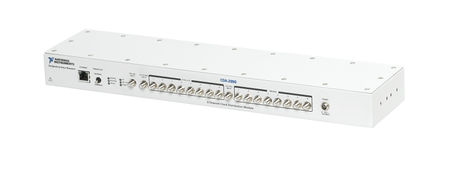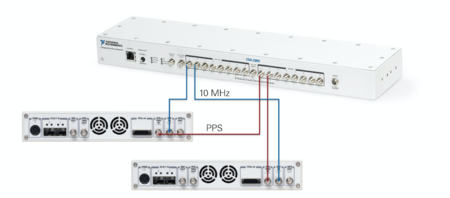OctoClock CDA-2990
Contents
Device Overview
The OctoClock CDA-2990 is an affordable solution for high-accuracy time and frequency reference distribution. The OctoClock accepts 10 MHz and PPS signals from an external source, and distributed each signal 8 ways. The OctoClock is a useful accessory for users that would like to build multi-channel systems that are synchronized to a common timing source.
The OctoClock-G CDA-2990 provides the same functionality as the OctoClock CDA-2990, but includes a GPSDO that can be used to produce internal 10 MHz and PPS signals, as well as a front-panel switch to select between internal and external sources for the signals. Note that both signals must come from the same chosen source: either both are generated internally from the GPSDO, or both are provided from the external inputs.
Note: Both of the CDA-2990 devices are functionally identical to the previous generation OctoClock, which contained an Ettus Research logo.
Key Features
|
Signal Levels
|
Physical Specifications
Dimension (1U Rackmount)
4 x 17.187x 1.75 inches
Weight
2.6 lbs
Drawings
CAD/STP Models
OctoClock CDA-2990
OctoClock CDA-2990
Environmental Specifications
Operating Temperature Range
- 0-40 °C
Operating Humidity Range
- 10% to 90% non-condensing
Input/Output Impedance
All RF Ports are matched to 50 Ohm with -10dB or better return loss generally. Detailed test is pending.
Ethernet Port
The Ethernet port on the OctoClock and OctoClock-G allows the device to be connected to the network. When connected, the uhd_find_devices utility can find any OctoClock devices on the network, and the device's firmware may be updated over Ethernet using the octoclock_burn_eeprom utility. In addition, with the OctoClock-G, NMEA strings may be obtained from the internal GPSDO via the UHD API. Note that there is no host CPU in the OctoClock, so it is not possible to SSH into the device.
Schematics
OctoClock
Key Component Datasheets
| Part Number | Description | Schematic ID (Page) |
|---|---|---|
| ENC28J60−DIG | Ethernet Controller | U103 (1) |
| ATmega128 | Microcontroller | U102 (1) |
| LC_XO Spec Sheet Manual | Jackson Labs LC_XO (OCXO) | U206 (2) |
| SN74AUP1T57 | VOLTAGE-LEVEL TRANSLATOR | U204, U203 (2) |
| CDCE18005−PWR | Output Clock Programmable Buffer | U205 (2) |
| 74HC4020 | Binary Ripple Counter | U207 (2) |
| LMZ12001 | Power Module | U101 (1) |
Certifications
RoHS
As of December 1st, 2010 all Ettus Research products are RoHS compliant unless otherwise noted. More information can be found at http://ettus.com/legal/rohs-information
China RoHS
Management Methods for Controlling Pollution Caused by Electronic Information Products Regulation
Chinese Customers
National Instruments is in compliance with the Chinese policy on the Restriction of Hazardous Substances (RoHS) used in Electronic Information Products. For more information about the National Instruments China RoHS compliance, visit ni.com/environment/rohs_china.
Certificate of Volatility
OctoClock
Firmware
The OctoClock's firmware is divided into two image files: octoclock_bootloader.hex and octoclock_r4_fw.hex. All image files can be found here, in version-specific ZIP files. Download the version corresponding to the version of UHD that you're running. You must use at least version 3.9.2.
- Full instructions on updating the OctoClock's firmware is located here: http://files.ettus.com/manual/page_octoclock.html#upgrading_device
- Source of the firmware for the OctoClock is located at: https://github.com/EttusResearch/uhd/tree/master/firmware/octoclock
Downloads
FA Q
- What is the OctoClock
The OctoClock is a USRP-compatible accessory that allows you to easily synchronize up to 8 USRP radios. Multiple OctoClock devices can be combined for synchronization of larger numbers of USRP radios.
- When would I used the OctoClock
The OctoClock is useful for synchronizing multiple USRP devices for high channel count systems.
The following applications can benefit from OctoClock clock distribution:
- Direction Finding
- Beamforming
- Adaptive Beamforming
- Multiple-In-Multiple-Out (MIMO) Prototyping
- Geolocation Systems that Use Time-Difference-of-Arrival (TDOA)
- Multi-Channel, Multi-Static, and Passive RADAR
- Multi-Band GPS Record and Playback
- Multi-Band Cellular Monitoring
Essentially, anything that requires from synchronization or the distribution of timing information would benefit from the use of the OctoClock.
- How does the OctoClock work
The OctoClock accepts 10 MHz and PPS signals from an external source. Active circuits are used to amplify and split the signals 8-ways. Matched-length traces minimize phase differences between all 10 MHz and 1 PPS outputs
The OctoClock-G includes an internal GPSDO (GPS Disciplined Oscillator) which provides an internal source for 10 MHz and PPS from an OCXO high precision oscillator. Add a GPS antenna (optional) with a clear view of the sky for GPS Disciplining of the OCXO that futher enhances frequency accuracy of the OCXO and global time synchronization.
- Where can I find user manuals for the OctoClock and USRP
Here is helpful document. Sync. and MIMO w/ the USRP
Also, here is some documentation on how to use UHD to interact with multi-USRP systems.
- What USRP model do you recommend for MIMO systems
The USRP N200 + N210, N310, N320 + N321, X300 / X310 are recommended for building high channel count and MIMO systems. These models provide external PPS and 10 MHz reference inputs. The USRP N200 and N210 support the USRP MIMO cable.
The USRP B100, B200, B210, E100, E110, and E310 can be synchronized with 10 MHz/PPS but are not phase coherent MIMO capable devices. The USRP1 cannot be synchronized with 10 MHz/PPS.
- How does the automatic switchover functionality work
When using the OctoClock-G, the Internal/External switch on the front panel allows the user to choose between the internal GPSDO and external source 10 MHz/PPS source. If the selected source is unavailable, the device will automatically switch over to the backup frequency source. When switchover is active the corresponding LED indicator will illuminate.
If neither source is present, the internal, external and status LEDs will not be illuminated and the user will not received valid 10 MHz/PPS outputs.
- What do the LED indications mean
The following list describes the behavior when each of the 6 LED status indicators is illuminated:
- Internal - internal GPSDO is selected and present.
- External - external source is selected and present
- Status - Either the internal GPSDO or external source is selected. If neither source is present this LED will turn off (no signals are output).
- PPS - selected PPS pulse high.
- GPS Locked - GPS is receiving signals and has valid time/position lock.
- Power - Power is applied.
- What are the input and output specifications
- 10 MHz Input – 0-10 dBm
- 10 MHz Outputs - ~1.4 Vpp Square Wave, Impedance 50 ohm nominal
- 1 PPS Input - Logic-level pulse, 2.5 V - 5 V
- 1 PPS Outputs - Logic-level pulse, 2.5 V - 5 V
- What is the input voltage rating
The OctoClock can be powered at any voltage between 6 and 15 Vdc.
- Are the design files open source
As with all of our products, the driver code is free & open source, and can be found in our UHD repository. The schematics are also available.




